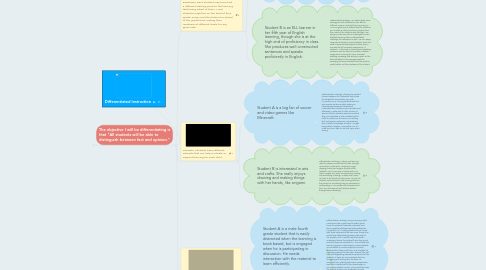
1. The objective I will be differentiating is that "All students will be able to distinguish between fact and opinion."
1.1. Readiness: Each student may have had a different starting point to the learning task being asked of them. Most students might be on the level of their grade, many could be behind or ahead of the grade level making their readiness at different levels for any given task.
1.1.1. Student A is an ELL learner in his fifth year of English learning, though his level of English proficiency is lower than average in the class. He struggles to produce properly constructed sentences, for example.
1.1.1.1. Differentiated Strategy: I am offering the same strategy for both students on this, but for different reasons. Blended learning using an LMS is a great way to differentiate for students. It allows students to have material at home or on their smart phones whenever and wherever they may be. For Student A, this allows the student to listen to native English speakers speak common sentences, so he can practice proficiency at his own pace. This is a strategy I currently use at my school and we are adding this technique next year, so students can hear our voices and home and repeat what we say as many times as they need. It also offers them the chance to practice speaking at their own pace by speaking into the microphone and answering questions that way. Offering an oral report of facts and opinions links the standard with a skill that the student needs practice with, but with support to make sure the student is successful and builds confidence.
1.1.2. Student B is an ELL learner in her fifth year of English learning, though she is at the high end of proficiency in class. She produces well constructed sentences and speaks proficiently in English.
1.1.2.1. Differentiated Strategy: I am offering the same strategy for both students on this, but for different reasons. Blended learning using an LMS is a great way to differentiate for students. For Student B, she tends to be a higher level than most of the students and although I am trying to make sure she is challenged in class, blended learning offers a differentiated challenge for homework as well. We can assign assignments based on each students' level and zone of proximal development rather than a one-size-fits-all homework assignment. If Student A is focused on listening and speaking, Student B can be asked to produce a written assignment covering the same standard. Reading a passage and writing a report on the facts identified in the passage would be assessing the same standard, but the product would better suit the readiness of the student.
1.2. Interests: Students have different interests that can help motivate or support learning for each child.
1.2.1. Student A is a big fan of soccer and video games like Minecraft.
1.2.1.1. Differentiation Strategy: Allowing for student choices deepens the motivation and allows the student to choose their own path (McCarthy, 2014). Having students use fact and opinion sentences while writing an informational paragraph helps them understand the concept more intimately and effectively. I make sure to offer choices of topics to let the students use base material they are interested in and confident with in order to make sure the focus in on writing fact and opinion sentences, not assessing their content knowledge. Student A enjoys being able to explain Minecraft to me, so I make sure he is able to use that topic when writing.
1.2.2. Student B is interested in arts and crafts. She really enjoys drawing and making things with her hands, like origami.
1.2.2.1. Differentiation Strategy: Making sure learning uses five senses is important to make stronger connections in the brain. Student B enjoys drawing (visual) and origami (tactile) crafts (Raffaelli, 2014). One way to utilize both is to make a poster of a story. Incorporating drawing and something to design, maybe even paper cut outs to be glued into the poster can get the student more involved in the learning because the product is something they are interested in participating in. The poster will showcase facts from an informational text that the student thought were interesting.
1.3. Learning Profiles: Each student may learn at their best in different ways. Offering different ways of learning material allows for all students to learn and takes into account the ways in which the students learn best.
1.3.1. Student A is a male fourth grade student that is easily distracted when the learning is book based, but is engaged when he is participating in discussion. He needs interaction with the material to learn efficiently.
1.3.1.1. Differentiation Strategy: Using Learning Profile Cards would be a great way to better get to know the students' interests, readiness, and learning styles (intelligences) and preferences (McCarthy, n.d.). Having students fill out a card with these ideas would do two major things that would help differentiating lesson planning for the student. First, it would help the teacher understand where the student thinks they are at and what they are interested in. This will help the teacher organize a class based on what students are confident on certain subjects and what students think they need help. This is helpful for organizing groups, for example. Second, this will help with organizing assessment products for the students. If there are many students that are struggling with writing (ELL students, for example), then offering alternative assessments would be a better test of their knowledge on non-writing related content. This would also help the teacher create more scaffolding to help students with their writing.
1.3.2. Student B is a female fourth grade student who is shy and prefers to work alone and read the material closely. She is a more analytical learner.
